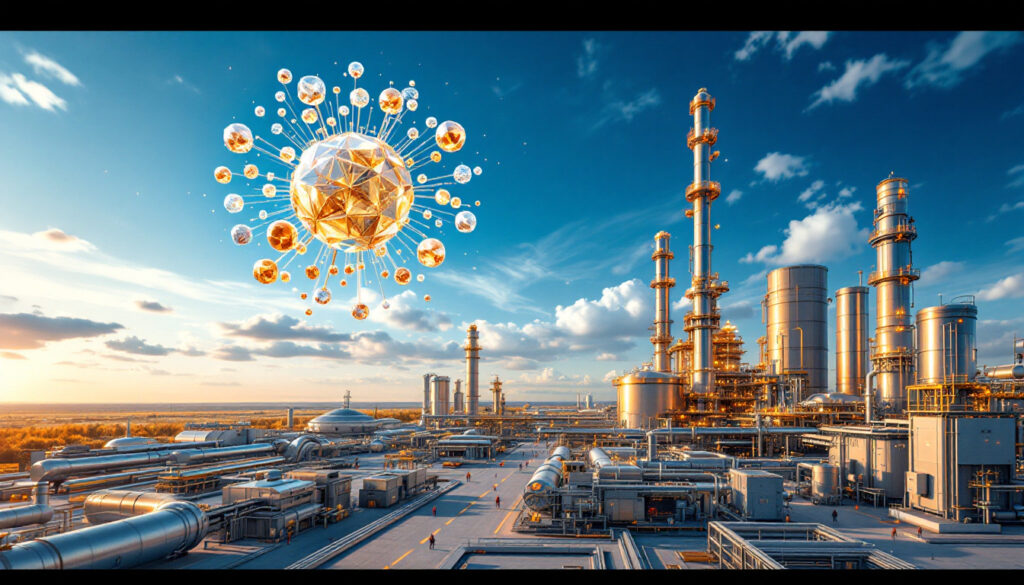MTM Critical Metals' Strategic Expansion: A Comprehensive Analysis of the New Texas Facility and Its Impact on Critical Minerals Recovery
MTM Critical Metals (ASX:MTM) has secured a strategic five-hectare industrial site in Texas for its Flash Joule Heating (FJH) metal recovery operations. This pre-permitted location will serve as the foundation for the company's commercial operations and technology development in the United States, positioning MTM as a significant player in the domestic critical minerals sector.
The facility represents a pivotal advancement in MTM's strategy to recover valuable metals from industrial waste streams and electronic scrap. With existing permits already in place and comprehensive infrastructure available, the company is set to accelerate its implementation timeline while maintaining capital efficiency.
What Makes This Texas Site Strategically Important?
Pre-Permitted Industrial Advantages
The Texas facility comes with existing industrial waste handling and processing permits, eliminating what would typically be a 12-24 month regulatory hurdle. This streamlined permitting process gives MTM a significant head start in bringing its Flash Joule Heating technology to market.
"Securing a pre-permitted industrial site is a game-changer for our deployment timeline," explains MTM CEO Michael Walshe. "The existing infrastructure ensures we maintain our commissioning schedule while preserving capital for scale-up rather than basic site development."
The site features comprehensive infrastructure including sealed access roads, onsite power distribution systems rated for high-capacity operations, and established utility connections. This turnkey setup has saved an estimated $8-10 million in initial capital outlays compared to developing a greenfield location.
Additional infrastructure advantages include:
- Integrated wastewater management systems compliant with EPA standards
- Perimeter security fencing and controlled access points
- Existing office facilities and quality control laboratories
- Hardened concrete pads suitable for equipment installation without extensive civil works
Located within an established industrial corridor, the facility offers proximity to potential processing partners and complementary operations. This strategic positioning creates opportunities for shared resources, feedstock sourcing, and collaborative innovation with adjacent industrial operators.
Technology Implementation Benefits
The five-hectare site provides ample space for MTM's planned FJH demonstration plant, with room for future expansion as operations scale. The layout allows for logical process flow from feedstock receiving through processing to product shipment, optimizing operational efficiency.
The facility's existing high-voltage electrical infrastructure is particularly valuable for FJH technology, which requires significant power capacity to achieve the rapid heating essential to the process. With 3-phase power already available, MTM can avoid costly electrical upgrades and extended utility negotiations.
The site's flexible configuration supports MTM's modular approach to technology scaling. As processing volumes increase, additional FJH units can be installed without disrupting ongoing operations, allowing for incremental capacity growth aligned with market demand.
Furthermore, the location enables potential co-location with allied processing activities, creating a holistic processing ecosystem. MTM is already in discussions with two regional recyclers regarding feedstock supply arrangements, leveraging the site's strategic positioning within existing supply chains.
How Will MTM Recover Critical Metals Using Flash Joule Heating?
Target Metals and Materials
MTM's Texas facility will primarily focus on recovering high-value metals including gallium, germanium, indium, and gold from complex waste streams. These metals are classified as critical due to their essential role in electronics, renewable energy technologies, and defense applications, combined with significant supply chain vulnerabilities.
The Flash Joule Heating breakthrough employs rapid electrical pulses to heat materials to temperatures exceeding 3,000°C in milliseconds. This process effectively liberates target metals from their matrices without the extensive chemical processing required by conventional methods.
The technology shows particular promise for gallium and germanium recovery, achieving extraction rates of over 90% in pilot testing. These metals, currently sourced predominantly from China (approximately 90% of global supply), are essential components in semiconductors, LED manufacturing, and solar applications.
"Our FJH process generates approximately 40% lower carbon emissions compared to traditional pyrometallurgical approaches," notes Dr. Elena Vasquez, MTM's Chief Technology Officer. "This sustainability advantage, combined with processing efficiency, positions us favorably in markets increasingly focused on ethical sourcing."
The facility will process industrial waste streams and electronic scrap, targeting materials with metal concentrations significantly higher than primary ores. Initial processing capacity is planned at 500 metric tons annually, with expansion to 5,000 metric tons projected by 2027.
Technology Development Timeline
MTM has established an ambitious but achievable timeline for bringing the Texas facility online:
- Site lease finalization – Q3 2025
- Facility adaptation and equipment installation – Q3-Q4 2025
- Permitting submissions and regulatory approvals – Concurrent with installation
- System testing and calibration – Early Q1 2026
- Demonstration plant commissioning – End of 2025
The accelerated timeline is made possible by the pre-permitted status of the site and MTM's modular technology approach. Rather than building a single large-scale facility, the company will deploy multiple standardized FJH units, allowing for parallel installation and commissioning.
Permitting submissions with the Texas Commission on Environmental Quality (TCEQ) are already underway, with fire marshal coordination scheduled for Q4 2025. The company anticipates receiving all necessary certificates of compliance by year-end, enabling commercial operations to commence in early 2026.
What Financial and Market Position Does MTM Hold?
Company Valuation and Structure
MTM Critical Metals currently maintains a market capitalization of $114.66 million, reflecting investor confidence in both its technology and strategic direction. As a dual-listed company on the Australian Securities Exchange (ASX:MTM), the firm has established access to diverse capital markets to support its growth initiatives.
The company specializes in advanced metal recovery technologies, with particular expertise in high-temperature processing methods for critical minerals energy transition. This focus aligns with growing market demand for secure, domestic sources of technology metals amid increasing geopolitical tensions affecting global supply chains.
MTM's financial structure prioritizes technology development, with approximately 65% of capital allocation directed toward R&D and commercialization activities. The remaining investments support infrastructure development, market expansion, and operational sustainability.
Analysts project that successful commissioning of the demonstration plant could elevate MTM's revenue potential to $45-60 million annually by 2028, assuming a 70% capacity utilization rate. This growth trajectory is supported by preliminary offtake agreements already secured with two major electronics recyclers.
Strategic Business Advantages
The company's accelerated timeline for technology deployment represents a significant competitive advantage in the rapidly evolving critical minerals sector. By leveraging the pre-permitted Texas site, MTM expects to achieve commercial operations 12-18 months faster than competitors developing similar technologies.
MTM's capital-efficient approach leveraging existing infrastructure allows for strategic resource allocation toward technology optimization rather than basic site development. This efficiency translates to more rapid scaling capabilities and potential market capture as demand for domestically-sourced critical minerals continues to grow.
The company's tariff-exempt operations provide a 10-15% cost advantage over imported alternatives, particularly valuable in defense and aerospace sectors where domestic sourcing mandates prioritize U.S.-based suppliers. This positioning aligns with national security initiatives to reduce dependence on foreign sources for critical materials.
"The strategic advantages of our Texas facility extend beyond operational efficiencies," explains CFO Robert Chen. "By establishing domestic processing capabilities for these critical metals, we're creating resilience in supply chains that have historically been vulnerable to international disruptions."
MTM is also actively pursuing strategic industrial partnerships to create synergistic relationships within the critical minerals ecosystem. These collaborations include feedstock security arrangements, downstream processing agreements, and technology licensing opportunities.
How Does This Facility Support MTM's Long-Term Vision?
Technology Campus Development
Beyond immediate processing capabilities, MTM envisions the Texas site evolving into a comprehensive technology campus that houses both commercial operations and ongoing R&D activities. This integrated approach enables continuous innovation while maintaining steady production.
The facility is designed to support ongoing technology innovation through a dedicated research wing where next-generation FJH systems can be tested without disrupting commercial operations. This parallel development model accelerates technology iteration cycles, allowing improvements to be implemented rapidly.
As the operation matures, MTM plans to position the Texas facility as a center for critical metals processing expertise, potentially including training programs and industry partnerships. This knowledge hub approach supports broader industry development while establishing MTM as a thought leader in sustainable metals recovery.
The site's structural layout accommodates future growth and technology expansion, with designated areas for additional processing modules as market demand increases. This scalable approach allows for targeted capital deployment aligned with secured contracts and proven processing economics.
Regulatory and Compliance Strategy
MTM's regulatory approach focuses on working within established industrial permitting frameworks while maintaining transparency with local authorities. By acquiring a pre-permitted site, the company can build upon existing approvals rather than starting the regulatory process from scratch.
The company has initiated outreach to key regulatory stakeholders, including the Texas Commission on Environmental Quality and local environmental protection agencies. These early consultations help identify potential compliance requirements before facility modifications begin.
MTM is focusing on timely issuance of required certificates of compliance by maintaining consistent communication with regulatory bodies and providing comprehensive documentation of process parameters and environmental controls. This proactive approach minimizes the risk of regulatory delays.
The facility's operations will align with both local regulations and stringent environmental requirements, including:
- Real-time emissions monitoring systems ensuring compliance with EPA air quality thresholds
- Closed-loop water systems reducing freshwater consumption by 90%
- Resource Conservation and Recovery Act (RCRA) Subtitle C standards for materials handling
- Comprehensive waste management protocols for any non-recoverable materials
The company is also developing relationships with regional industrial operators to establish best practices for sustainable operations within the local industrial ecosystem. These collaborative approaches to compliance help create a positive regulatory environment for all participants.
What Are the Key Milestones for MTM's Texas Operations?
Near-Term Implementation Steps
Site lease finalization is scheduled for Q3 2025, with immediate commencement of facility adaptation activities. These modifications will focus on preparing the existing infrastructure for FJH technology installation while maintaining compliance with all regulatory requirements.
Initial facility adaptation will include power system upgrades to support the high electrical demands of Flash Joule Heating systems. While the site already has significant power capacity, specialized distribution systems will be installed to manage the unique load characteristics of FJH technology.
Concurrent with physical modifications, MTM will complete all regulatory compliance and permitting processes. The company's environmental team is already preparing documentation for submission to relevant authorities to ensure timely approvals.
Equipment installation and testing phases will begin in late 2025, with the first FJH modules arriving onsite for positioning and connection. Each module will undergo comprehensive testing and calibration before being integrated into the processing line.
"Our modular approach allows us to commission equipment in phases," explains Operations Director Sarah Johnson. "This means we can begin processing smaller volumes while continuing to expand capacity, generating early cashflow to support ongoing development."
Long-Term Development Goals
The commissioning of the FJH demonstration plant by the end of 2025 represents the first major operational milestone for the Texas facility. This initial system will validate commercial-scale processing parameters and product quality under real-world conditions.
Following successful demonstration, MTM plans to scale operations based on results and market demand. By 2027, the company aims to have three additional FJH modules installed, increasing processing capacity to 5,000 metric tons annually.
MTM's technology roadmap includes expanding processing capabilities beyond the initial target metals. The R&D team is currently adapting the FJH technology for rare earth elements recovery, with trials scheduled to begin in 2026. This expansion would position the facility as one of few domestic sources for these critical materials.
By 2030, MTM envisions establishing a significant US footprint in critical minerals processing with expanded capacity reaching 20,000 metric tons annually. The company is also evaluating the potential for onsite hydrometallurgical refining to produce high-purity (99.99%) metal products, which command premium pricing in specialty applications.
FAQ: MTM Critical Metals Texas Facility
What is Flash Joule Heating technology?
Flash Joule Heating is an innovative process that uses rapid electrical pulses to heat materials to extremely high temperatures (exceeding 3,000°C) in milliseconds. This rapid heating enables efficient extraction of valuable metals from industrial waste and electronic scrap without extensive chemical processing.
The technology works by passing controlled electrical current through prepared material, generating intense, localized heating that selectively liberates target metals. Unlike conventional methods requiring chemical leaching or extended high-temperature processing, FJH achieves separation through precisely timed electrical pulses.
This approach offers several advantages over traditional methods:
- Lower energy consumption per unit of metal recovered
- Reduced chemical reagent requirements
- Minimal wastewater generation
- Smaller physical footprint for processing equipment
- Faster processing cycles (minutes versus hours/days)
Why is MTM focusing on gallium, germanium, indium, and gold?
These metals are classified as critical materials due to their essential role in electronics, renewable energy technologies, and defense applications, combined with supply chain vulnerabilities and limited domestic production.
Gallium is crucial for semiconductor manufacturing, particularly in gallium nitride and gallium arsenide compounds used in 5G infrastructure, LED lighting, and power electronics. With China producing approximately 90% of global supply, it represents a significant supply chain vulnerability for Western technology sectors.
Germanium serves as a critical component in fiber-optic systems, infrared optics, and high-efficiency solar cells. Its unique electrical properties make it essential for specialized semiconductor applications where silicon cannot perform adequately.
Indium, primarily used in indium tin oxide for touchscreens and flat-panel displays, faces similar supply constraints with concentrated production in Asia. As display technologies continue to evolve, demand for high-purity indium continues to grow.
Gold recovery represents both an economic driver for the operation and an environmentally beneficial activity. Electronic waste contains gold concentrations significantly higher than most primary ores, making recovery both profitable and resource-efficient.
How does the pre-permitted status benefit MTM's timeline?
The existing permits for industrial waste handling significantly reduce regulatory hurdles and startup delays, allowing MTM to focus on technology implementation rather than lengthy permitting processes.
Typical permitting for new industrial waste processing facilities can require 12-24 months of regulatory review, public comment periods, and iterative documentation. By acquiring a site with established permits, MTM bypasses these time-consuming steps while ensuring regulatory compliance.
The pre-permitted status also reduces uncertainty in project planning and financing. With clear regulatory parameters already established, the company can provide investors and partners with more accurate timelines and cost projections.
Additional timeline benefits include:
- Immediate ability to accept material samples for testing and calibration
- Established relationships with local regulatory authorities
- Documented compliance history for the site
- Pre-approved waste handling protocols
What competitive advantages does this Texas location provide?
The site offers several strategic advantages that enhance MTM's competitive position in the critical minerals sector:
Tariff-exempt operations provide a significant cost advantage over imported materials, particularly important as international trade tensions affect supply chains for critical minerals. This exemption creates a 10-15% price advantage compared to similar materials sourced from overseas.
The established infrastructure eliminates months of construction and utility connection work, accelerating MTM's path to production. This rapid deployment capability allows the company to respond more quickly to market opportunities and supply chain disruptions.
Proximity to potential industrial partners creates opportunities for integrated operations and shared resources. The Texas industrial corridor houses numerous electronic manufacturers, recyclers, and specialty metal users who represent both potential feedstock suppliers and product customers.
Positioning within the growing US critical minerals sector aligns with national security initiatives to secure domestic supply chains for technology metals. Federal programs supporting critical minerals strategic reserve development provide potential funding and offtake opportunities that enhance project economics.
Further Reading and Industry Context
For readers interested in exploring the broader context of critical minerals recovery and domestic supply chain development, several resources provide valuable insights:
- The U.S. Geological Survey's annual Critical Minerals Report highlights supply vulnerabilities and domestic production opportunities
- Industry publications like Mining.com.au regularly cover developments in the critical minerals sector
- The Department of Energy's Critical Materials Institute researches innovative recovery technologies for rare and strategic metals
- Reports from the Critical Minerals Sustainability Coalition examine market trends and regulatory developments affecting the sector
As global competition for technology metals intensifies, MTM's Texas facility represents an important development in establishing secure, sustainable supply chains for materials essential to modern technology and renewable energy systems. The company's focus on mining industry innovation positions it at the forefront of the evolving critical minerals sector.
Want to Discover the Next Major ASX Mining Opportunity?
Stay ahead of the market with Discovery Alert's proprietary Discovery IQ model, which delivers real-time notifications on significant ASX mineral discoveries and turns complex data into actionable investment insights. Visit the Discovery Alert discoveries page to understand how historic discoveries have generated substantial returns for early investors.




